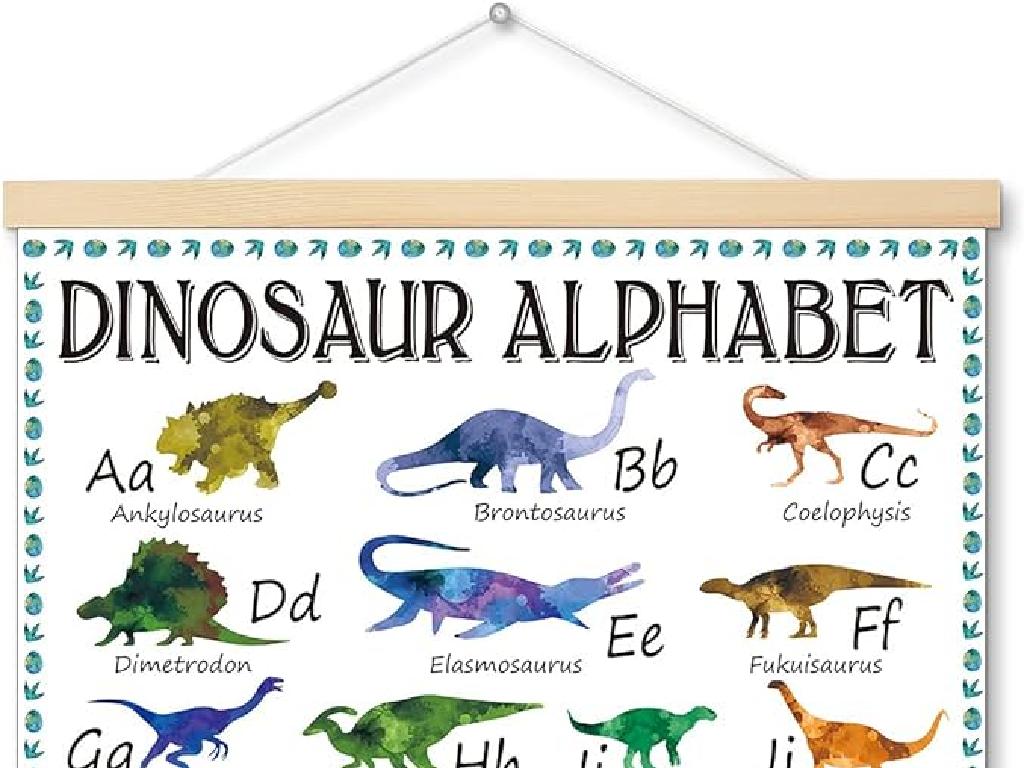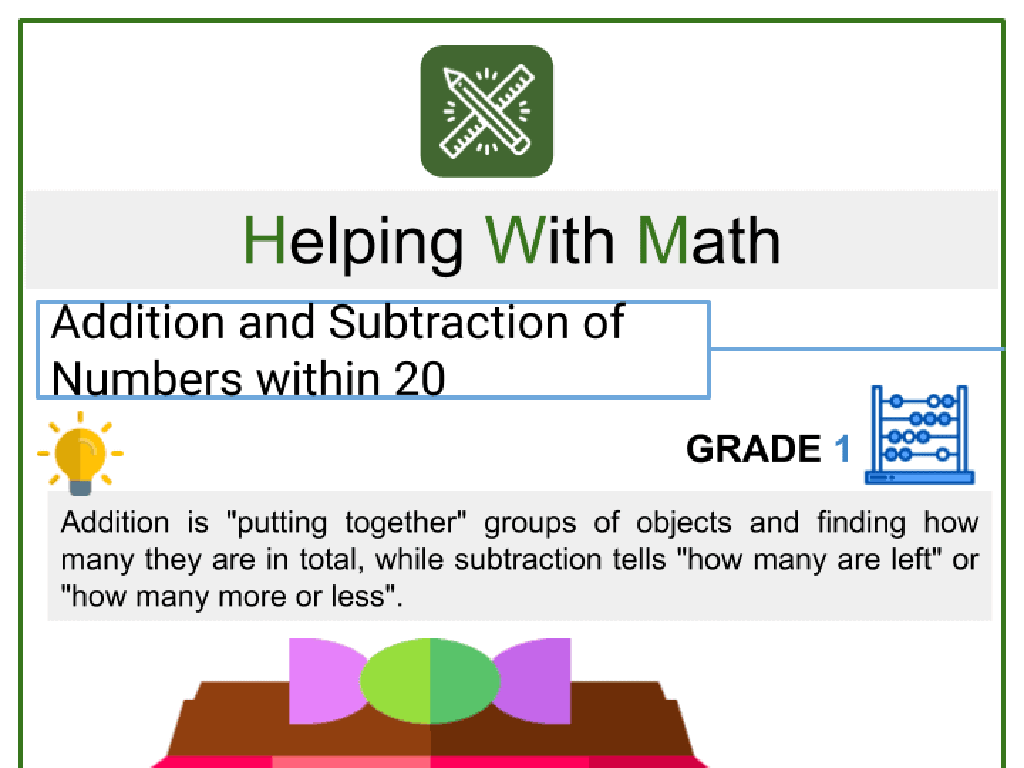Write A Ratio: Word Problems
Subject: Math
Grade: Sixth grade
Topic: Ratios And Rates
Please LOG IN to download the presentation. Access is available to registered users only.
View More Content
Introduction to Ratios
– Define a ratio
– A ratio shows the relative sizes of two or more values.
– Examples of ratios
– If there are 2 apples and 3 oranges, the ratio of apples to oranges is 2:3.
– Ratios in real life
– Ratios are used in recipes, maps, and to compare prices.
– Significance of understanding ratios
– Grasping ratios is crucial for problem-solving and decision-making.
|
This slide introduces the concept of ratios, which are an essential part of mathematics and are used to compare quantities. Start by defining a ratio and ensure students understand that it shows the relationship between two or more numbers. Use everyday examples, such as comparing the number of apples to oranges, to illustrate how ratios work. Discuss how ratios are applied in real-life situations like cooking, where they help in maintaining the proportions of ingredients, or in understanding distances on a map. Emphasize the importance of understanding ratios as they are foundational for more advanced math topics and practical life skills, such as budgeting and making purchases.
Understanding Ratios Through Word Problems
– Read and interpret word problems
– Understand the story to solve the problem
– Identify key information for ratios
– Look for numbers and comparative words
– Write ratios from word problems
– Use the format part:part or part:whole
– Practice with examples
– Example: If there are 2 apples and 3 bananas, write the ratio of apples to bananas as 2:3
|
This slide aims to guide students through the process of understanding, identifying, and writing ratios from word problems. Start by reading the problem carefully to grasp the context. Teach students to look for key numerical information and words that indicate comparison, such as ‘for every’, ‘out of’, or ‘per’. Explain the two common formats for writing ratios and when to use each. Provide practice problems where students can apply these steps, such as finding the ratio of different types of items or comparing quantities. Encourage students to share their thought process when writing ratios from word problems to reinforce learning.
Understanding Ratios Through Word Problems
– Example 1: Apples to Oranges
– If a fruit bowl has 3 apples and 5 oranges, the ratio of apples to oranges is 3:5.
– Example 2: Books in the Library
– A library has 600 science books and 900 literature books, the book ratio is 2:3.
– Solving ratio problems
– Class discussion of solutions
– We’ll review different methods to solve these problems and understand the concept of ratio.
|
This slide introduces students to the concept of ratios through relatable word problems. Start with simple examples like comparing the number of apples to oranges to help students grasp the idea of expressing relationships between quantities. Move on to a slightly more complex scenario like the ratio of books in a library to show ratios in different contexts. After presenting the problems, work through the solutions as a class, encouraging students to participate and discuss their approaches. This will help them understand the process of solving ratio problems and how to apply this knowledge in various situations. Ensure to provide guidance on how to simplify ratios and make them relatable to everyday situations.
Ratio Word Problems: Practice Session
– Solve word problems together
– We’ll tackle a few problems as a class to learn the process.
– Write ratios independently
– Try writing ratios from word problems on your own.
– Share and explain your answers
– Discuss your solutions and the strategies you used.
– Understand ratio concepts
|
This slide is designed for a collaborative and interactive class activity focused on solving ratio word problems. Begin by solving a few problems together as a class to demonstrate the process of writing ratios from word problems. Then, allow students to attempt writing ratios on their own, providing a variety of word problems that require them to think critically and apply what they’ve learned. Afterward, have students share their answers with the class and explain the reasoning behind their process. This will help reinforce their understanding and allow them to learn from each other. Encourage students to ask questions and discuss different approaches to the problems. Possible activities could include peer review, group discussions, or presenting solutions to the class. The goal is to build confidence in writing ratios and understanding their use in real-world contexts.
Class Activity: Ratio Scavenger Hunt
– Find classroom objects for ratios
– Record your findings as ratios
– Example: 4 red books to 6 blue books = 4:6
– Present your ratios to the class
– Discuss the ratios with your peers
– Why did you choose those objects? How did you determine the ratio?
|
This interactive activity is designed to help students understand ratios by finding and forming them with objects in their immediate environment. Students will search the classroom for items they can use to create ratios, such as pencils to erasers or windows to doors. They should write down each ratio they find and be prepared to present their findings to the class. After presentations, facilitate a group discussion to explore the different ratios discovered, focusing on the reasoning behind their choices and the methods they used to determine the ratios. Provide guidance on simplifying ratios and ensure that each student participates in both finding and discussing the ratios. Possible variations for different students could include finding ratios in pictures, textbook examples, or even ratios related to the number of students wearing different colors.
Wrapping Up: Ratios Around Us
– Review of ratio concepts
– Homework: Discover 5 ratios
– Find everyday items to form ratios
– Explore ratios in your home
– Examples: Socks in a drawer, fruits in a basket
– Next class: Introduction to Rates
|
As we conclude today’s lesson on writing ratios, ensure students have grasped the concept of ratios as a comparison between two quantities. For homework, students should look for examples of ratios in their daily lives, such as the number of windows to doors in their house or the amount of forks to spoons in their kitchen drawer. Encourage creativity and practical application of today’s lesson. Prepare students for the upcoming lesson on rates by explaining that rates are an extension of ratios, providing a sneak peek into how they differ and relate. This will set the stage for a smooth transition to the next concept.





